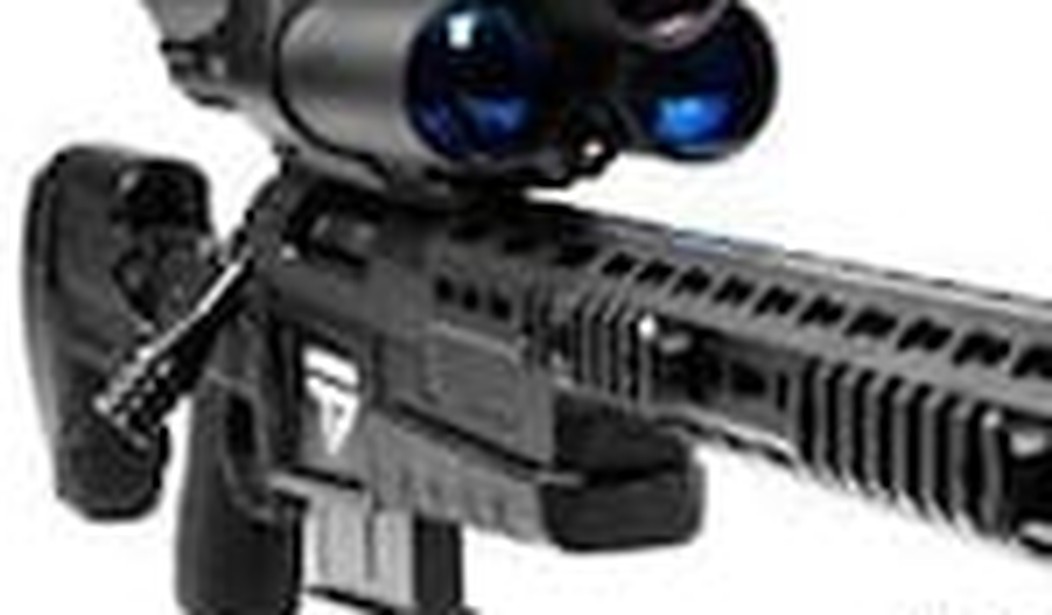I’m an early adopter of new technologies, an avid — if not terribly good — FPS (first-person shooter) gamer, and a middling rifleman. Given a precision, dialed-in, scoped rifle, I’ve hit a grapefruit-sized target repeatedly at 460 yards. I just missed, a foot low, when engaging a man-sized target at 833 yards because I anticipated the shot.
So I should be TrackingPoint’s biggest fan. I’m not.
TrackingPoint promises to eliminate the little errors that separate recreational shooters from true marksmen. It is the first integrated long-range shooting system (firearm, optic, ammunition, networked computing), and it has technology news outlets as curious as shooting sports media. (Ars Technica, TechCrunch, and other tech sites have examined the product.) NPR gagged over the company’s claim of being the first “precision guided firearm” (PGF); Defense Review loved it. ABC7 in Denver sums up how it works:
The shooter presses one button to lock on the target and squeezes and holds the trigger to arm the system. When the weapon is optimally aligned, the Networked Tracking Scope releases the guided trigger.
“Using the PGF, you can be an elite, long-range marksman in minutes,” the website promises.
However, due to “overwhelming demand,” the only way to purchase a PGR is to reserve a spot on the waiting list.
There are several PGR models differentiated by caliber, barrel length, chassis system, application, and ammunition. They range in price from $17,000 to $22,000.
Summed up: you look through the scope to identify your target, and press a button located on the front of the trigger guard to mark it. Once marked, an interrupter mechanism kicks in as you squeeze the trigger. It only allows the shot to fire once the crosshairs intersect a second time with the spot you marked.
The rifle itself is built using parts from a “who’s who” in the world of manufacturing precision long-range rifle parts, including a Surgeon action, Krieger barrel, and an Accuracy International AX chassis. The ammunition — .338 Lapua in one version, .300 Winchester Magnum for the two smaller rifles — is custom-loaded for the gun.
The part of the system that makes the headlines isn’t the rifle itself, but how the rifle interfaces with software and a sensor package straight out of Predator to come as close as possible to creating a “can’t miss” scenario at long range for even the least-experienced shooters.
Amazing. And I find myself hating it.
Well, hate might be a strong word. The intersection of software engineering, hardware, and ballistic programming that went into the “brains” of the system is incredibly cool, and I’d love to be able to review the nuts and bolts of the system to see how they put it all together. I’d be fascinated to hear how they integrated a heads-up display (HUD) — similar to what our military pilots use — with the sensors and software that make the system work. I want to understand the mechanical engineering and software interface that controls when the system fires.
I’m very interested to see how it functions under a wide range of environmental variables. Will it work in cloudy conditions, in the fog, or at night? I want to know how durable it is. Will the $17,000 system short out in a sudden downburst? Will it go belly-up from one of the X-class solar flares the sun seems to be firing out in all directions lately?
Can it get a virus? Can it be hacked?
These are the questions I should be pursuing, but I just don’t care enough, and that may be the core problem with the entire concept. Specifically: the kind of people who have both the funding and the passion for long-range precision rifles seem left out of the equation. Who is the buyer here?
A $17,000 to $22,000 firearm that “can’t miss” and which has a cool technological edge is awesome — when someone else is footing the bill for you to fire it. The majority of people who consider themselves serious shooters, the kind who will sink thousands of dollars into a rifle, thousands more into a scope, and tens of thousands into ammunition and new barrels, enjoy the process of shooting.
Serious shooters are the heart and soul of America’s gun culture. They spend countless hours refining their skills and their own handloaded ammunition, they document every variable of every shot, and they enjoy learning every tic and nuance of their rifle, scope, and ammunition to the end of their system’s effective range in all sorts of conditions. They do this because in a very real sense they are craftsmen, honing a unique skill with a precision tool.
TrackingPoint is the auto-tuning of ballistic skill and craftsmanship: what is this product for, exactly?
It doesn’t carry with it the soul of the sport, and for that sin, it will inevitably fail among those who love and care about shooting.









Join the conversation as a VIP Member